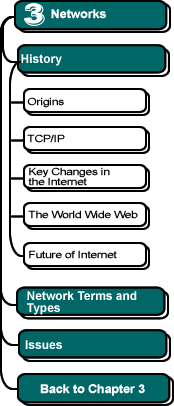

|
IP - Internet Protocol
IP is the other principal protocol of TCP/IP.
IP defines the format of the packets (datagrams). However, it is best known for providing the address scheme according to which the Internet operates.
 Consider
this: global telephone calls are possible because of a prescribed format
for telephone numbers that ensures there are no duplicate phone numbers.
Also, a postal system works because it defines an address format and also
depends upon unique mail addresses.
Consider
this: global telephone calls are possible because of a prescribed format
for telephone numbers that ensures there are no duplicate phone numbers.
Also, a postal system works because it defines an address format and also
depends upon unique mail addresses.
Similarly, the IP address scheme specifies an Internet address format and also assures that there are no duplicate addresses on the Internet.
The basic format for an IP address is four 3-digit numbers between 0 and 255, separated by periods referred to as dots. For example, the IP address of the Web server at Calvin is: 153.106.4.23
This is sometimes called dotted decimal format because of the "dots" involved and also because each of the four numbers is written as a decimal, even though it is actually a binary number.
Why do the numbers fall between 0 and 255? Because each of these numbers is actually an 8-bit binary number— i.e., one byte. And what is the largest number that can be stored in one byte? Answer:
11111111
which in decimal is written 255.
Thus, this IP address scheme is a 32-bit address scheme, because it consists of four 8-bit numbers.
![]()
![]()
This chapter was written by Jeff Nyhoff and Joel Adams. Copy editing by
Nancy Zylstra
©2005 Calvin University (formerly Calvin College), All Rights Reserved
If you encounter technical errors, contact computing@calvin.edu.